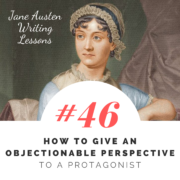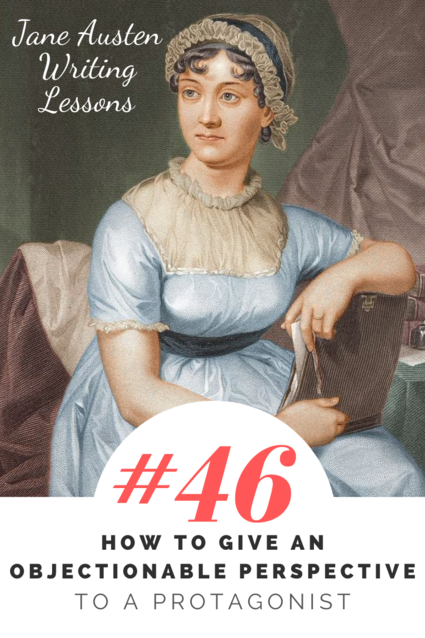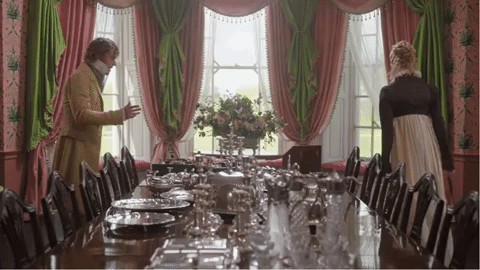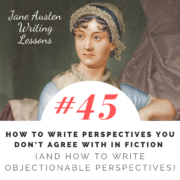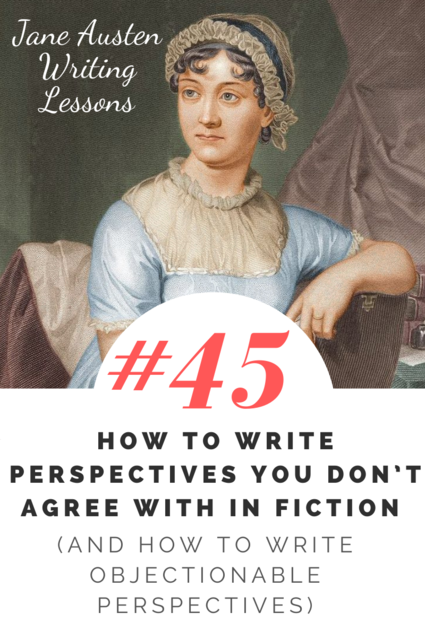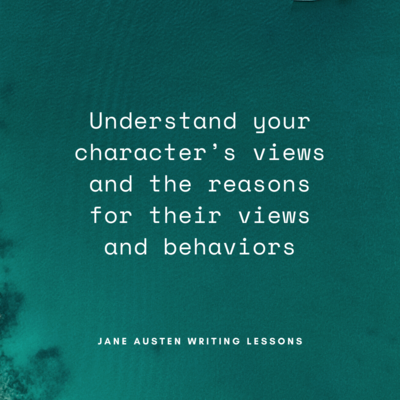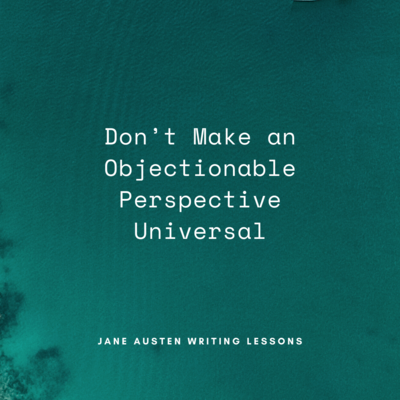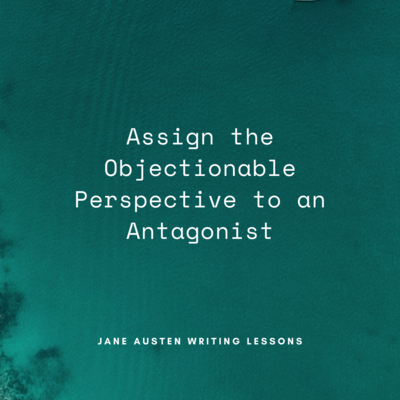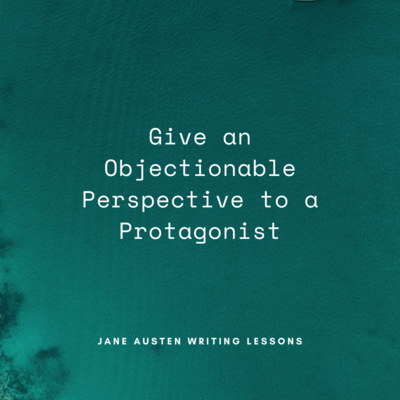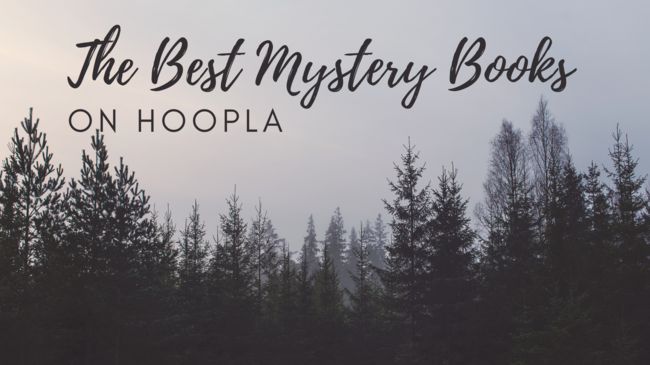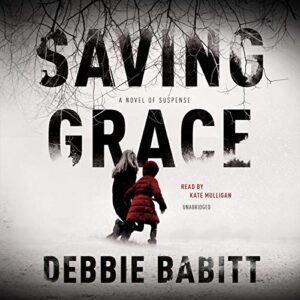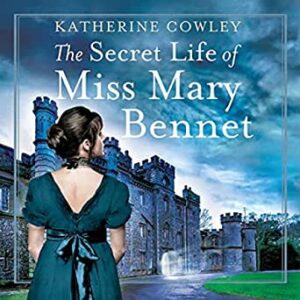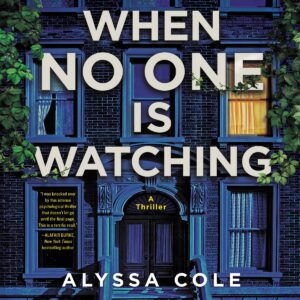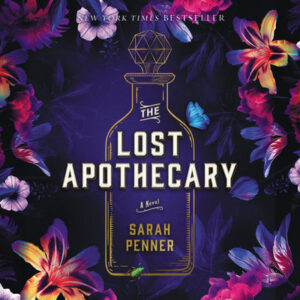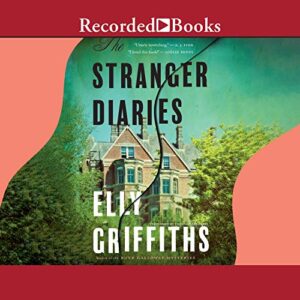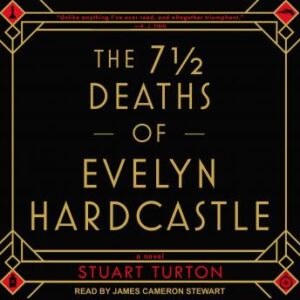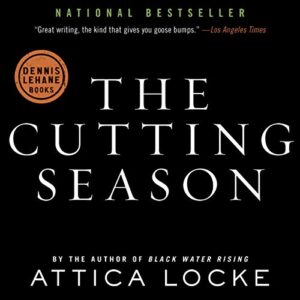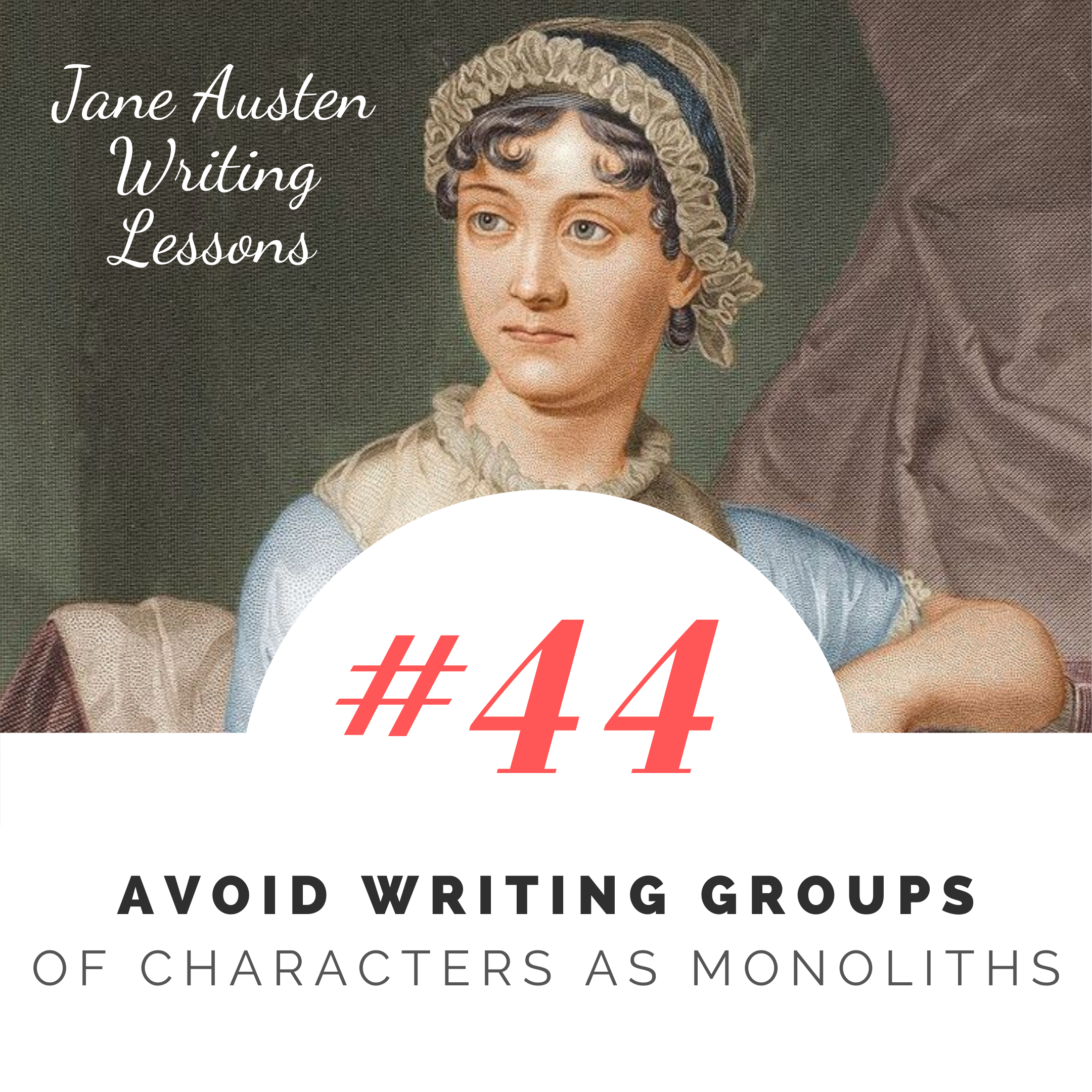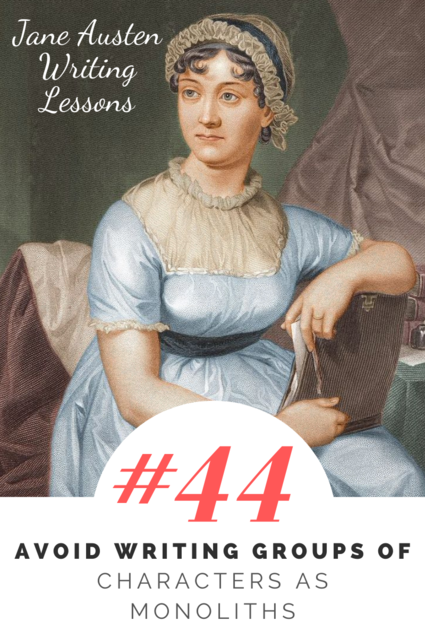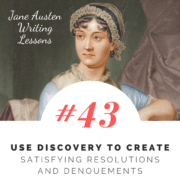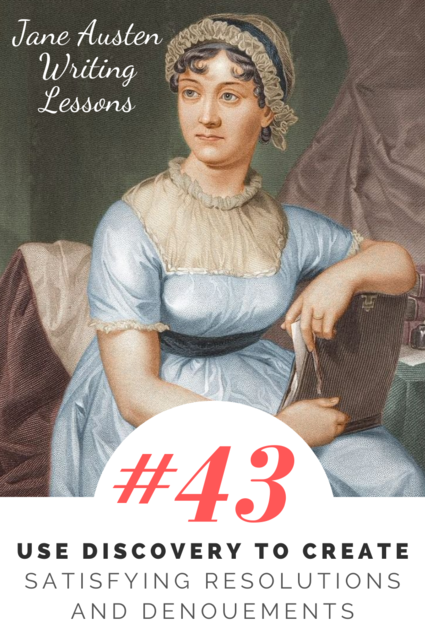#46: How to Give an Objectionable Perspective to a Protagonist
Often, objectionable opinions—ones the author strongly disagrees with—are assigned to antagonists: if the perspective belongs to an antagonist, it is easy to represent it without condoning it.
Yet our protagonists should not be perfect people—they need flaws and weaknesses, and sometimes even objectionable perspectives that actively cause harm to others.
An example of this is Emma, the title character and protagonist of Jane Austen’s novel Emma. She is the protagonist, and while at times the narrator makes commentary on her, the narrative voice generally leans into her perspective.
Emma is clever, handsome, and rich. She has a dominant, influential position in her society. She also holds objectionable viewpoints on who has value; she believes her perspective is always superior to that of anyone else; she is judgmental, classist, and self-centered.
So how do you give an objectionable perspective to a protagonist?
1. Understand your character’s views and the reasons for their views and behaviors
In last week’s lesson, we discussed the importance of understanding your character’s views, even—and especially—when you disagree with them. This is also essential when a protagonist holds objectionable perspectives, and when these objectionable perspectives lead to negative behaviors.
After giving a little background on Emma’s character and situation, the narrator helps us understand the reasons for Emma’s perspectives:
The real evils, indeed, of Emma’s situation were the power of having rather too much her own way, and a disposition to think a little too well of herself; these were the disadvantages which threatened alloy to her many enjoyments. The danger, however, was at present so unperceived, that they did not by any means rank as misfortunes with her.
This does not necessarily absolve Emma of her approach, but it does help us understand her.
2. Craft an unreliable narrator
An unreliable narrator is one who cannot give us a full perspective—or chooses not to. When using a close third person point of view (as much of Emma does), or when writing in first person, readers are given the story through a character’s lens. No character can see the big picture—every character is limited by their experiences, their knowledge, and their interactions with other. If the character has an objectionable perspective, this can make them even more unreliable: everything they see or experience will be filtered through that perspective and their understanding of the world.
This happens constantly in the novel Emma. Emma has disliked (and been jealous of) Jane Fairfax since childhood. When Jane Fairfax returns to Highbury, Emma is forced to renew their acquaintance. In the following passage, we can see her making judgments on Jane—both positive and negative. We can also see her coming to conclusions about Jane being in love with Mr. Dixon, who happens to be the husband of Jane’s best friend. The evidence provided throughout the novel supports that conclusion—because it is filtered through Emma’s perspective. Yet Emma is completely wrong in this judgment, and this interpretation of events is used by Emma to cause harm to Jane later. Here’s a passage describing part of Emma and Jane’s first visit after Jane’s return:
In short, [Emma] sat, during the first visit, looking at Jane Fairfax with twofold complacency; the sense of pleasure and the sense of rendering justice, and was determining that she would dislike her no longer. When she took in her history, indeed, her situation, as well as her beauty; when she considered what all this elegance was destined to, what she was going to sink from, how she was going to live, it seemed impossible to feel any thing but compassion and respect; especially, if to every well-known particular entitling her to interest, were added the highly probable circumstance of an attachment to Mr. Dixon, which she had so naturally started to herself. In that case, nothing could be more pitiable or more honourable than the sacrifices she had resolved on. Emma was very willing now to acquit her of having seduced Mr. Dixon’s actions from his wife, or of any thing mischievous which her imagination had suggested at first. If it were love, it might be simple, single, successless love on her side alone. She might have been unconsciously sucking in the sad poison, while a sharer of his conversation with her friend….
An unreliable narrator is powerful because it invites us to embrace the perspectives—we cannot help doing it, at least to an extent—and yet we gradually realize, as we read, that the narrator is unreliable, which can lead us question the validity of their perspectives.
3. Incorporate a voice that disagrees
If a character has an objectionable perspective, there should always be another character that disagrees with them. Sometimes this disagreeing character takes on the perspective of the author; at other times, this disagreeing character provides other viewpoints which may not represent the author’s perspective, yet still oppose that of the main character.
No matter what time period, no matter what group of people, in real life there has always been someone who has disagreed with objectionable perspectives, even when those perspectives seem almost universal.
In the novel Emma, because Emma is in a place of power and privilege in her community, almost no one will voice any opposition to her. This includes people that could or should oppose some of her viewpoints or behaviors, people like Emma’s father, or her former governess, who did not voice disagreement or objection even when acting as a governess.
Yet despite Emma’s power, there is still a character willing to criticize Emma and point out the flaws in her perspective: Mr. Knightley.
After Emma convinces Harriet to turn down Mr. Martin’s proposal, Emma has a discussion with Mr. Knightley.
Mr. Knightley confides in Emma that Harriet may soon be receiving an offer of marriage, and Emma explains that the offer has already happened, and that Harriet declined via a letter.
Mr. Knightley is shocked:
“You saw her answer!—you wrote her answer too. Emma, this is your doing. You persuaded her to refuse him.”
“And if I did, (which, however, I am far from allowing) I should not feel that I had done wrong. Mr. Martin is a very respectable young man, but I cannot admit him to be Harriet’s equal; and am rather surprized indeed that he should have ventured to address her. By your account, he does seem to have had some scruples. It is a pity that they were ever got over.”
“Not Harriet’s equal!” exclaimed Mr. Knightley loudly and warmly; and with calmer asperity, added, a few moments afterwards, “No, he is not her equal indeed, for he is as much her superior in sense as in situation. Emma, your infatuation about that girl blinds you.”
Mr. Knightley then continues with another 298 words of criticism. Emma presents counterarguments and Mr. Knightley returns in kind.
Emma is not convinced by Mr. Knightley’s arguments—she does not really listen to them, and it does not change her perspective or behavior. Yet despite that, it is a key part of Mr. Knightley’s character to oppose her, and it is essential for Emma to know that her perspective is not universally shared and that others may see it as flawed.
Having an alternative perspective invites the reader to see the flaws in the objectionable perspective. It also sets up the main character for either growth or tragedy.
Emma and Mr. Knightley arguing in the 2020 film Emma.
4. Create an opportunity for growth or tragedy
Giving a character an objectionable perspective for growth or change—if the character realizes the problems with their perspective, they have the possibility for a powerful character arc as they transform and become someone better.
If they choose not to transform, then it opens the door for tragedy, in which the readers and the character experience the consequences of not changing.
Throughout the novel, Emma hurts many characters including Mr. Martin, Mr. Elton, Jane Fairfax, Harriet Smith, and Miss Bates. It is when she insults and hurts Mrs. Bates at Box Hill that she begins to feel guilt for her behavior (and Mr. Knightley criticizes Emma’s behavior, not allowing her to brush it off).
The next chapter begins:
The wretchedness of a scheme to Box Hill was in Emma’s thoughts all the evening. How it might be considered by the rest of the party, she could not tell. They, in their different homes, and their different ways, might be looking back on it with pleasure; but in her view it was a morning more completely misspent, more totally bare of rational satisfaction at the time, and more to be abhorred in recollection, than any she had ever passed.
At this point, Emma could continue to act as she has—assuming her perspective is superior and justifying her actions. Yet instead, she goes to visit Miss Bates, and for once she is truly interested in Miss Bates’ conversation and appreciative of Miss Bates’ virtues.
There is still regression for Emma—still opportunities when her harmful perspectives come into play and she risks a tragic ending—but ultimately she begins to transform and heal some of the damage she has done.
Endowing Emma with objectionable perspectives gave her great opportunities throughout the novel. By the end, she’s still a bit classist, still overconfident at times, but some of her core problematic perspectives have shifted.
Note: There are characters who do not grow, and yet do not suffer tragedy, such as Jane Austen’s title character in Lady Susan.
Conclusion
Giving a protagonist an objectionable perspective can be a powerful tool, and you can give them this perspective without condoning it.
In the next lesson I’ll discuss how characters justify their behavior, especially when it’s negative behavior.
Exercise 1: Write a scene from the perspective of an unreliable narrator, where their viewpoint taints or colors their interpretation of the world around them. Give one or two clues to the reader that this perspective may be unreliable.
Exercise 2: Make a list of characters or protagonists you like (from any storytelling medium) and their viewpoints or perspectives that you disagree with. Consider why you like these characters despite disagreeing with them.
Book Unboxing Video for The True Confessions of a London Spy
I have a confession to make.
I love snow.
Not the “it’s March and it’s been snowing non-stop for five months and my car just slid off the road” snow. But in general, I love snow. Watching it fall, bundling up and walking through a snow-filled forest, making snow angels with my kids, drinking hot cocoa next to a fire with snow falling outside the window.
Mary Bennet doesn’t necessarily feel so positively about snow. In January and February of 1814 London received feet of snow (at one point, there were mounds of snow five feet high). It got so cold that the Thames River froze over and an ice fair was held on it. Which all is part of my book The True Confessions of a London Spy.
My advance copies of The True Confessions of a London Spy arrived, so I just had to unbox them in the snow.
The weather is practically a character in the book. Here’s a short excerpt of the first few chapters which gives a feel for the book and a taste of the snow:
When Miss Mary Bennet agreed to become a spy for the British government, she had not realised how many dead bodies the job would entail. True, since accidentally discovering a corpse on the beach in Worthing she had not seen any additional individuals bereft of life, but now she was headed to London for her first time in an official capacity, and she already had an appointment to call upon a corpse.
The carriage windows fogged with the warmth of their breaths. Despite pressing her feet against a hot rock, Mary’s toes felt frigid. She shifted closer to Fanny, one of her fellow spies, to better share the blanket they held over themselves. The other inhabitant of the carriage, a spy named Mr. Withrow, rubbed his gloved hands together.
Snow continued to fall outside the carriage, adding to the piles already on the London streets. A man stood on a roof, pushing at the two or three feet of accumulated snow. It fell heavily onto the walk and road below, to the anger of a couple who had walked into the snow shower.
The book comes out on March 1, 2022, but it is now available for preorder–links are on the main page on my website for The True Confessions of a London Spy. Preordering helps show initial support for the book and makes sure that the publisher prints enough copies.
And now, I should get back to editing book 3 in the series, which comes out late next year.
#45: How to Write Perspectives You Don’t Agree With in Fiction (And How to Write Objectionable Perspectives)
One of the powers of writing fiction is that you are able to write characters who are not like you—they can have different backgrounds, different skills, different desires, different circumstances.
But sometimes, for the purposes of plot or character or theme, you need to write fictional perspectives that you don’t agree with.
Sometimes these might be perspectives that take a different philosophy on life—in Sense and Sensibility, Mrs. Jennings attempts to pry into Elinor’s life to discover who Elinor favors, despite the subject making Elinor uncomfortable:
When Mrs. Jennings attacked [Elinor’s sister Margaret] one evening at the park, to give the name of the young man who was Elinor’s particular favourite, which had been long a matter of great curiosity to her, Margaret answered by looking at her sister, and saying, “I must not tell, may I, Elinor?”
This of course made every body laugh; and Elinor tried to laugh too. But the effort was painful. She was convinced that Margaret had fixed on a person whose name she could not bear with composure to become a standing joke with Mrs. Jennings.
Mrs. Jennings pushes and pushes until she discovers from Margaret that the name begins with F, and it makes Elinor extremely uncomfortable.
Yet there are also perspectives that Austen represents in her novels that are much more objectionable. As you write your own stories, you may need to write a character who you not only disagree with, but whose views (and resulting actions) you find reprehensible.
How do you write perspectives you don’t agree with in fiction? And how do you write objectionable perspectives?
Understand your character’s views and the reasons for their views and behaviors
In order to write a character, you must understand them. In Sense and Sensibility, Lucy Steele manipulates the protagonist, Elinor, by sharing secrets and extracting promises from her. Lucy causes Elinor much pain.
Yet she is an effective character, because Austen understand her views:
Lucy Steele is a woman grasping for a respectable place in life. The man she loved and made promises to when younger seems to be in love with someone else. If we were in her place, wouldn’t many of us want to try to do something?
When characters have objectionable perspectives on life, they often have reasons for it, things in their past and their present that have influences their views and behavior.
Their motives for these views and their behavior might be inwardly focused, like selfishness, a desire for power, or a disregard for societal mores. Their motives might be outwardly focused, such as spite, revenge, or jealousy. Their motives for these objectionable perspectives might more positive—they might think they are benefiting others by their behavior. And sometimes a character might have an objectionable viewpoint because they believe the ends justify the means or they lack the understanding and knowledge to see the negative implications of their negative viewpoints.
At the beginning of the year I wrote a post about giving antagonists redemptive qualities. In that post I discussed John Willoughby as a character in Sense and Sensibility. He makes choices that cause active harm to the protagonists, yet his motives are clear, and while some of his motives and perspectives are harmful, others are positive. In a poignant and powerful passages that is often cut from film adaptations, John Willoughby is given an entire scene in which to express his viewpoints, his regrets, and his justifications. He knows the harm he has caused, yet refuses to give up some of his objectionable perspectives. But because we see his story, we feel for him, and Elinor feels for him.
Don’t Make an Objectionable Perspective Universal
When you write a character with an objectionable perspective, don’t make that perspective universal, especially within groups or categories to which a character belongs.
As I discussed in the previous post, groups of characters should not be written as monoliths—within any group there is a range of perspectives and opinions. While a character may have a particular objectionable perspective, not everyone within their societal class, religion, race, nationality, or any other sort of group will have that perspective. It can be harmful to people within those groups if you represent an objectionable perspective as universal.
For example, some of the most objectionable perspectives on life in Sense and Sensibility are held by Fanny Dashwood and her mother, Mrs. Ferrars. Fanny is selfish and more than willing to deprive Mrs. Dashwood and her daughters of any support. Mrs. Ferrars is very classist, as she is also controlling, vindictive, and cruel. Yet one of their other family members, Edward Ferrars, is shown in a completely different light. While his choices sometimes cause Elinor pain, he does not want to cause her pain and he spends the story trying to be good and honorable to everyone.
(Note: sometimes in Austen novels, you have only one character from a group, for example, Mr. Collins is the only clergyman character in Pride and Prejudice. Yet his views are not universalized as representative of all clergymen.)
Assign the Objectionable Perspective to an Antagonist
When representing an objectionable perspective, the goal as a writer is likely not to condone that viewpoint. This is the reason why, in many novels, the truly objectionable perspectives are given to antagonists.
Because an antagonist interferes with the main character, it is often made clear that their behavior and the viewpoints that lead to this behavior are not advocated by the narrator or the writer.
Let’s consider, once again, the selfish perspective of Fanny Dashwood:
Mrs. John Dashwood did not at all approve of what her husband intended to do for his sisters. To take three thousand pounds from the fortune of their dear little boy would be impoverishing him to the most dreadful degree. She begged him to think again on the subject. How could he answer it to himself to rob his child, and his only child too, of so large a sum? And what possible claim could the Miss Dashwoods, who were related to him only by half blood, which she considered as no relationship at all, have on his generosity to so large an amount. It was very well known that no affection was ever supposed to exist between the children of any man by different marriages; and why was he to ruin himself, and their poor little Harry, by giving away all his money to his half sisters?
Through use of free indirect speech and a summary of Fanny’s arguments, we are given Fanny’s perspective, and it is an objectionable one.
Yet Austen’s narrator does not moralize or directly condemn. Austen does not take a heavy, didactic approach, which would lessen the beauty and effectiveness of her novels. Rather, she allows Fanny to show her perspective, and throughout the novel she explores the impact of this perspectives on the main characters as they are, in essence, cast out of their home.
Next Lesson: How to Give an Objectionable Perspective to a Protagonist
While it’s easier to write an objectionable perspective in an antagonist, it can be extremely effective to write an objectionable perspective in a protagonist. That will be the subject of the next lesson.
Exercise 1: Think of a modern perspective that you find objectionable. This could be something political, something social, or something you’ve read about in the news. Read several blog posts or articles from people who have this perspective. Then write a scene in which a character holds this perspective. Try to write them in a way that is fair to their motives and the reasons for their behavior.
Exercise 2: Who is your favorite villain or antagonist? Write a paragraph about the objectionable viewpoint or viewpoints that they hold, and how these are represented in the text.
Exercise 3: Analyze a draft that you have written. Do you have any characters with objectionable perspective? What is working well about the representation of this character and this perspective? How could this representation be improved? If you don’t have any objectionable perspectives, would it be useful to add one?
The Best Mystery Books on Hoopla
I listen to a lot of audiobooks and read a lot of ebooks, and mystery is one of my favorite genres, so today I’m going to share ten of the best mystery books on Hoopla. Hoopla is my go-to for listening to audiobooks or reading ebooks—it’s free to access through many libraries across the country, and it makes it so you can listen to an audiobook or read an ebook on your phone, your tablet, or your computer.
In no particular order, here are
10 of the Best Mystery Books on Hoopla (in audiobook and/or ebook):
Part 1: Mysteries available as Audiobooks
Lives Laid Away by Stephen Mack Jones
This novel features an ex-cop living in Mexicantown in Detroit, who takes it on himself to right wrongs in his community. It’s a thrilling, pulse-racing novel, filled with action and gritty intensity.
Saving Grace by Debbie Babitt
This suspense novel features the first female sheriff in a small town, and a disappearance that brings up decades-old crimes and threatens to fracture the community.
The Secret Life of Miss Mary Bennet by Katherine Cowley
This mystery novel features Mary Bennet, the dull, plain, overlooked sister of Jane Austen’s Pride and Prejudice… but there is more in store for Mary, and when there is a murder at Castle Durrington, she becomes a spy, intent on unravelling the mystery.
(Disclaimer: I’m the author of this book. I’m including it because the narrator is an incredible British comedian who has narrated the entire works of Jane Austen, and she brings the characters and the story to life.)
When No One is Watching by Alyssa Cole
This is an intense Edgar award-winning thriller novel that gives up Hitchcock Rear Window vibes. Neighbors are moving and the neighborhood is becoming gentrified, but the reasons may be sinister…
The Haunting of Tram Car 015 by P. Djèlí Clark
This fantastic mystery novella is only three hours long, and is perfect if you’re in need of a short listen. It’s also perfect for those who like a little fantasy mixed in with their mystery—it features detectives in an alternate history Egypt dealing with djinn and trying to resolve a high-profile tram haunting.
Part 2: Mysteries available as both Audiobooks and Ebooks
The Lost Apothecary by Sarah Penner
This is a compelling dual-timeline mystery, in which a modern-day woman runs to London—away from her cheating husband—and discovers a clue in the River Thames to a centuries-old mystery. It’s available in ebook and audiobook—I listened to the audiobook, and I loved the three narrators, one for each of the three main characters.
Mango, Mambo, and Murder by Raquel V. Reyes
Culinary mysteries hold a special place in my heart—food and murder, both things that must be shared, right? This is a Caribbean Kitchen mystery, with a dead body at a luncheon…the mystery of which must be solved by our food anthropologist heroine.
The Stranger Diaries by Elly Griffiths
This is a modern Gothic mystery book featuring a high school teacher, Clare Cassidy. Someone is found dead, and on the body is a line from one of Clare’s favorite Gothic stories. The boundaries between reality and fiction become blurred as Clare is drawn into the mystery.
The 7 and ½ Deaths of Evelyn Hardcastle by Stuart Turton
This book is Groundhog Day meets an Agatha Christie closed-door whodunnit. The investigator must relive a certain day in different bodies as he tries to discover the solution to an impossible murder.
Listen to The 7 and 1/2 Deaths of Evelyn Hardcastle on Hoopla
The Cutting Season by Attica Locke
This is a gripping thriller with two interwoven mysteries—the death of a migrant worker at an antebellum plantation turned tourist attraction, and a missing slave from a hundred years before. Locke is a master storyteller, and the book has been a finalist for a number of awards.
The Best Mysteries on Hoopla: The Classics
You can’t talk about the best mystery books on Hoopla without addressing the classics. A number of classic mystery novels are available, including Elizabeth Peters’ Crocodile on the Sandbank, a huge number of Agatha Christie’s novels, many Sherlock Holmes stories, and the works of Edgar Allan Poe.
Do you have other favorite mystery novels on Hoopla? If so, share in the comments!
Other Mystery Audiobooks
I wrote a new post with my recommendations for full length mystery audiobooks. Some are available on Hoopla; others are available on Libby, Audible, and Libro.fm.
#44: Avoid Writing Groups of Characters as Monoliths
In real life and in fiction, people are part of groups.
Some groups are chosen—for example, in Pride and Prejudice, people have chosen friendship groups, such as Mr. Darcy’s friendship with Mr. Bingley and Colonel Fitzwilliam, or Elizabeth Bennet’s friendship with Jane Bennet and Charlotte Lucas. Other people choose to join a group such an occupation—for example, Mr. Collins becoming a clergyman.
Other groups are formed more naturally or organically, like five Bennet sisters, who did not choose to be sisters, and yet, because of their birth into the same family, share many commonalities.
Many groups are constructs by society or other people. For example, the gentry is a societal construct that impacts many of Jane Austen’s characters.
There are many other types of groups, defined by religion, race, physical characteristics, nationality, personal interests…the possibilities are endless.
In order for people to be part of a group they must share things in common, and often they share many things in common. While these commonalities are essential, the risk in writing groups of people is representing them as monoliths.
(Image of the Utah monolith by Patrick A. Mackie, CC license)
A monolith is a large stone, often made a single material.
When you write a group of people as a monolith, you treat them as uniform and homogenous. They have the same perspectives, the same attributes, the same belief systems.
Yet this is not an accurate representation. The five Bennet sisters are each very different. Not every clergyman in Austen’s novels is like Mr. Collins. The gentry in Pride and Prejudice have very different lifestyles and resources: Sir William Lucas is titled, but comes from an occupational background; Mr. Bennet owns land but cannot pass anything to his daughters; Georgiana Darcy is set to inherit a large fortune; Anne de Bourgh also will inherit, but struggles with health problems.
Not everyone with the same religion, race, class, or nationality is of one mind on any issue.
If you write a group of people as a monolith, it is easy to fall into stereotypes, and some of these stereotypes can be damaging and harmful. If you are writing a group that you are not part of or are not familiar with, you increase your risk of writing a group as a monolith or using harmful stereotypes. When you’re not part of a group, you must take the effort to become fluent in the range of people and perspectives within a group.
Writing a group as a monolith also misses out on so many fictional possibilities.
The goal is to give individuals within a group a range of perspectives and attributes.
When you do so, it:
- Allows for greater tension
- Produces genuine obstacles
- Fosters more possibilities for character growth, and
- Creates higher stakes and risks in relationships.
Let’s look at how Jane Austen introduces a single group of people in Pride and Prejudice: Mr. Bingley’s party at the Netherfield Assembly.
Mr. Bingley
Mr. Bingley was good-looking and gentlemanlike; he had a pleasant countenance, and easy, unaffected manners.
Mr. Bingley’s sisters (Miss Caroline Bingley and Mrs. Louisa Hurst)
His sisters were fine women, with an air of decided fashion.
Mr. Hurst
His brother-in-law, Mr. Hurst, merely looked the gentleman;
Mr. Darcy
but his friend Mr. Darcy soon drew the attention of the room by his fine, tall person, handsome features, noble mien, and the report which was in general circulation within five minutes after his entrance, of his having ten thousand a year….he was looked at with great admiration for about half the evening, till his manners gave a disgust which turned the tide of his popularity; for he was discovered to be proud, to be above his company, and above being pleased; and not all his large estate in Derbyshire could then save him from having a most forbidding, disagreeable countenance, and being unworthy to be compared with his friend.
What unifies this group is clear: they are all with Mr. Bingley, and they each have a level of fortune and prestige. Yet even at this initial introduction of these characters, all of the other characters are doing their best to figure out the group’s distinguishing features.
Jane Austen’s narrator makes contrasts between members of the Bingley party time and time again. Many of these contrasts are about the differences between Mr. Bingley and Mr. Darcy, but key contrasts are made between other combinations of characters, such as Mr. Darcy and Mr. Hurst:
Mr. Darcy said very little, and Mr. Hurst nothing at all. The former was divided between admiration of the brilliancy which exercise had given to her complexion, and doubt as to the occasion’s justifying her coming so far alone. The latter was thinking only of his breakfast.
Creating contrasts between characters who are very similar
The two characters in the group who are the most similar are Mrs. Hurst and Miss Bingley. In some cases, such as the 2005 film adaptation of Pride and Prejudice, their characters are even combined into one character, because of their similarities.
Yes, one is married and one is single, but they are both prideful, judgmental, conniving, kind to Jane, and unkind to Elizabeth.
But even in their similar attributes, Jane Austen gives them marked differences:
- Caroline Bingley’s attention is constantly on Mr. Darcy. Her every word is calculated to endear herself to him.
- Louisa Hurst pays Darcy attention, but is just as likely to pay attention to others, watch cardplaying, or play with her bracelets.
- It is always Miss Bingley who begins the criticism of Elizabeth or her family. It is a topic that she takes great personal interest in, largely because she wants to distinguish between herself and Elizabeth and feel superior to her.
- Louisa Hurst is more of a follower. She likes to be part of the conversation, so once Miss Bingley has begun a critique, then she joins in and they feed off of each other. Yet she seems that she is involved more for the sport of it and for the approval of her sister.
Here’s a brief excerpt from the novel where we see this distinction:
When dinner was over, [Elizabeth] returned directly to Jane, and Miss Bingley began abusing her as soon as she was out of the room. Her manners were pronounced to be very bad indeed, a mixture of pride and impertinence; she had no conversation, no style, no taste, no beauty. Mrs. Hurst thought the same, and added,
“She has nothing, in short, to recommend her, but being an excellent walker. I shall never forget her appearance this morning. She really looked almost wild.”
“She did, indeed, Louisa. I could hardly keep my countenance. Very nonsensical to come at all! Why must she be scampering about the country, because her sister had a cold? Her hair so untidy, so blowsy!”
When Jane Austen writes groups of characters, they are never monoliths. Each group contains a range of perspectives and attributes, which is part of what makes her character groupings interesting and memorable.
Exercise 1: Write a few paragraphs about your own membership in a group:
What is a group that you are a part of? What attributes unify the members of the groups? What makes group members different? Even in attributes that group members share, what differences are there?
Exercise 2: Take a book or a movie that you have read or watched recently and make a list of all the different groups of people in the story. Do the groups change over time? How do the groups interact? Are there people who are not fully part of the groups, or who are trying to enter or interact with a particular group?
Exercise 3: Write a scene with two characters who are very similar (like Louisa Hurst and Caroline Bingley). Make sure to give them several key distinctions which differentiate them throughout the scene and create a more real dynamic.
#43: Use Discovery to Create Satisfying Resolutions and Denouements
If an airplane pilot crashes the plane while landing, it doesn’t matter how good the rest of the ride was. The same goes for novels—if you don’t land the ending, the book will not be satisfying.
Jane Austen is a novelist who always “lands the ending.” One of the main ways she does this is by incorporating discoveries into the resolution of the story: in particular, she uses discoveries to answer the big questions that have been raised throughout the story.
In lesson 40, we talked about some of the big questions raised in the novel Persuasion, including:
- What will Anne’s future look like?
- Can Anne and Wentworth reconcile?
Most of the other big questions in the book have been explored and answered by the time we hit the last two chapters of the novel, but not these two questions. Characters and readers have yet to discover the resolution.
The second to last chapter of Persuasion acts as the final “unravelling,” the final section of the climax sequence where the most important questions must be answer, the most important discoveries made. In this chapter, Anne and Captain Harville discuss love and the inconstancies of men and women—who suffers the most from loss of love? Whose feelings are the most tender, the most constant? Captain Wentworth overhears their conversation, and as a result of Anne’s words, writes her a letter which begins:
I can listen no longer in silence. I must speak to you by such means as are within my reach. You pierce my soul. I am half agony, half hope. Tell me not that I am too late, that such precious feelings are gone for ever. I offer myself to you again with a heart even more your own, than when you almost broke it eight years and a half ago. Dare not say that man forgets sooner than a woman, that his love has an earlier death. I have loved none but you.
Upon reading the letter, Anne cannot sit still—she goes out into Bath, and when she sees Captain Wentworth, she joins him on a walk. And here, here we discover the answers we’ve been seeking. Anne and Captain Wentworth do reconcile, they express their love to each other, and they become engaged.
In a novel, when questions are raised for the characters, readers want answers by the end of the story. Some of these discoveries occur, and should occur, throughout the book, but some should be saved for the end.
Answering a key question or key questions near the end of the novel provides a satisfying resolution for both the characters and the reader.
In Persuasion the key discoveries are made in the second to last chapter. But there are still more discoveries saved for the denouement.
Discoveries in the Denouement
The denouement serves to show what happens as a result of the final resolution. It is a chance for characters to make any final smaller discoveries, to show any relationship changes, and to wrap up any lingering subplots which have not been resolved.
In the novel Persuasion, the final chapter serves as the denouement. It begins with the following paragraph, which reassures us that the key questions will truly be resolved in the way in which we as readers hope:
Who can be in doubt of what followed? When any two young people take it into their heads to marry, they are pretty sure by perseverance to carry their point, be they ever so poor, or ever so imprudent, or ever so little likely to be necessary to each other’s ultimate comfort. This may be bad morality to conclude with, but I believe it to be truth; and if such parties succeed, how should a Captain Wentworth and an Anne Elliot, with the advantage of maturity of mind, consciousness of right, and one independent fortune between them, fail of bearing down every opposition?
There are a number of other minor discoveries in the final chapter as part of the denouement:
- We discover Sir Walter’s view on his daughter’s engagement. He approves (he decides that Captain Wentworth has a nice balance of physical attractiveness and fortune, which are two of the only things that matter to him).
- We discover that Anne’s sister Mary is happy for her, and (mostly) not jealous.
- We discover how Anne’s other suitor, Mr. Elliot reacts:
The news of his cousin Anne’s engagement burst on Mr. Elliot most unexpectedly. It deranged his best plan of domestic happiness, his best hope of keeping Sir Walter single by the watchfulness which a son-in-law’s rights would have given.
- We discover that Mrs. Clay has become Mr. Elliot’s mistress (and thus, Anne’s father Sir Walter is safe from Mrs. Clay’s scheming).
- We discover that Lady Russell and Captain Wentworth are able to reconcile with each other. This is an important discover, as Lady Russell was the person who convinced Anne to break off her original engagement to Wentworth eight years before.
- We discover the resolution to the subplot of Anne’s friend Mrs. Smith being in poverty: Captain Wentworth is able to use his connections to secure Mrs. Smith’s fortunes, her health improves, and she maintains a good friendship with Anne.
Austen, of course, never leaves her endings completely tidy—there’s never a sense of complete assured happiness. In the final paragraph, we read:
Anne was tenderness itself, and she had the full worth of it in Captain Wentworth’s affection. His profession was all that could ever make her friends wish that tenderness less; the dread of a future war all that could dim her sunshine. She gloried in being a sailor’s wife, but she must pay the tax of quick alarm…
Austen makes no pretense that Anne and Wentworth’s lives will be perfect. But it is a wonderful resolution because it answers the core, larger questions of the book. It’s a wonderful resolution because this discovery is made in a beautiful way. And it’s a wonderful resolution because the denouement is able to provide the reader with discoveries for lingering questions and subplots.
A Recap
We’ve spent the past seven lessons talking about discovery. To recap, we covered:
- Why you should give your characters things to discover
- How to establish an information gap or start a character on the journey toward discovery
- How to create a progression of knowledge discovery
- How to use distractions, interruptions, and red herrings
- How to use foreshadowing
- How to use large discoveries and plot twists
- Using discovery in the resolution and denouement (this lesson)
Discovery is a powerful tool that can be used in any sort of fiction to drive the character forward and invoke the reader’s interest. Ultimately, the process of discovery assists the character on their external journey, as they interact with the world and find their place in it. Discovery is also fundamental to a character’s internal journey: it gives them reason to change, and sometimes the greatest discoveries come from reflection about themselves, as characters recognize who they really are.
Exercise 1: Write a new denouement
Take a short story or a novel that you have written and write a new denouement. Keep the main resolution the same, but write a different denouement, which resolves subplots, relationships, and other small discoveries in a new way.
Exercise 2: Write just the ending of a story
The author Victoria Schwab (also published as V.E. Schwab) writes her climax and denouement first, before writing anything else. In episode 15.42 of Writing Excuses she explained, “I don’t do anything until I’ve planned the ending. The ending…and that climax through the last page determines the entire story I’m telling….Rather than write toward the end, and think ‘What kind of resolution do I need in order to fulfill the promises I’ve made early on?’, I write backwards, from the end, and make those promises from the ending that I know I want to achieve.”
Take a story idea that you haven’t used and write the ending. To reemphasize—you are just writing the ending of the story, not the beginning or the middle. Consider what sorts of discoveries would you like your characters to make at the end of the story, and what emotions you would like to evoke in your reader. Also, ask yourself the same question that Victoria Schwab asks herself: “Who are my characters the moment we leave them?”
Once you’ve written the ending, consider what storytelling it will take to reach this ending, and how to get your characters to this point.
Exercise 3: Best and Worst Endings
Think of two stories, one which had a satisfying and rewarding ending, and another which had an ending that didn’t quite work for you. Now go back and analyze the endings—what specifically made the endings effective and ineffective for you as a reader?

